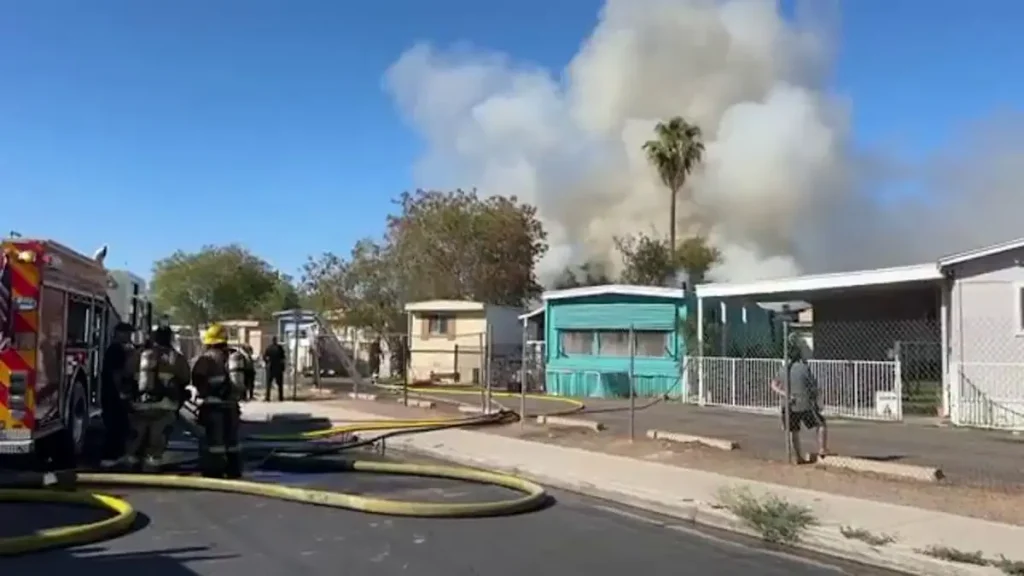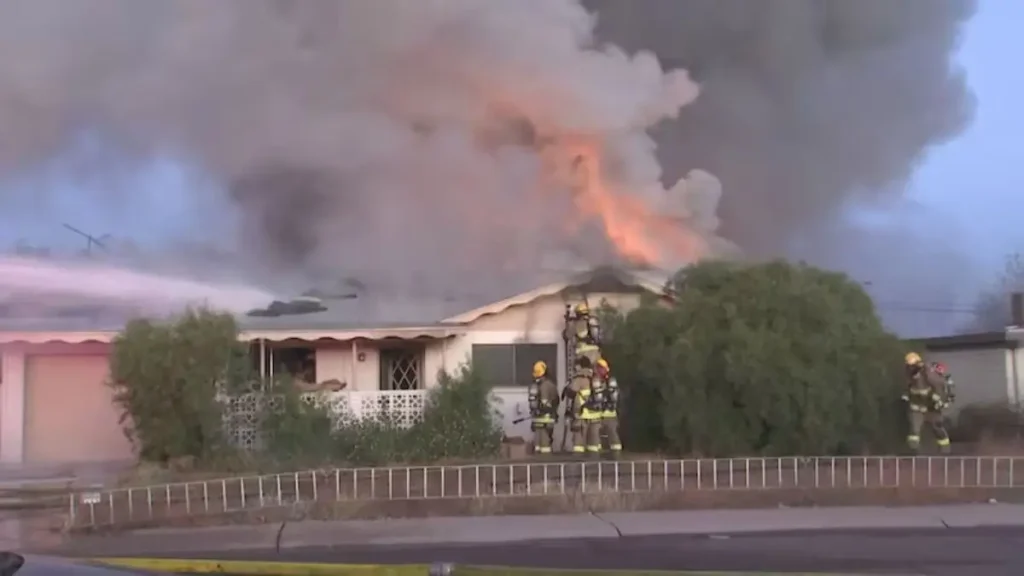Phoenix Mobile Home Park Fire Destroys Homes and Displaces More Than 30 People
On Sunday afternoon, a fire tore through a mobile home park near 43rd Avenue and Van Buren Street in Phoenix. It moved fast—within minutes, thick black smoke covered the area and five homes were burning. Over 30 people were forced to leave everything behind. Families. Pets. Memories. Gone in one brutal wave of flames.
I’ve seen a lot of fire coverage over the years, but what stood out here wasn’t just the scale—it was how suddenly it all unfolded. The Phoenix Fire Department called it a “first-alarm” fire, which means multiple units rushed in. They fought hard to keep the flames from spreading to even more homes.
No one was seriously hurt, and that’s something to be thankful for. But let’s be real—just because everyone made it out alive doesn’t mean they’re okay. Thirty-plus people are now without a place to sleep tonight. Most of them didn’t have time to grab anything. Some barely escaped with their pets in their arms.
If you live in Phoenix—or anywhere near a mobile home park—you’re probably wondering, “Could this happen to me?” That’s a question we’ll come back to. But first, it’s worth understanding exactly how this fire unfolded, and why these parks are especially vulnerable.
How Firefighters Responded?
I followed the updates in real time—and if you were on Twitter that day, you might’ve seen what Phoenix Fire posted too. They called it a “first-alarm fire,” which isn’t something they declare lightly. That means multiple units were pulled in immediately because the situation was already big and moving fast.
They had to divide the scene into sectors—different zones—to keep the fire from jumping further. That’s usually a sign things were out of control at first. Firefighters also had to dodge electrical hazards because power lines were down and sparking. You can imagine how dangerous that gets when metal trailers and dry Phoenix heat are involved.
Phoenix Fire (@PHXFire) posted an on-the-ground update showing heavy smoke and active hose lines. You could see the urgency in how they moved. They weren’t just fighting fire—they were trying to stop a disaster from turning worse.
Firefighters are currently battling multiple mobile home fires near 43rd Ave. and Van Buren. At this time the assignment is at a first alarm. pic.twitter.com/iY83inGHpB
— Phoenix Fire Dept. (@PHXFire) June 22, 2025
If you’ve ever thought, “It won’t happen to me,” this is your reminder. Fires in mobile home parks spread differently. Faster. Hotter. And firefighters have to think on their feet.
What Residents Went Through?
When I watched the interviews from the scene, one voice stuck with me—Esperanza Reyes. She said the fire jumped from home to home “in just minutes.” Think about that. One moment you’re eating lunch, and the next you’re dragging your dog out of the house barefoot.
She wasn’t alone. More than 30 people had to evacuate—some left with just a phone in hand. One woman had to leave behind her pet fish, and others rushed to save dogs or birds. No time to think. Just panic, smoke, and heat.
If you’ve never been through something like this, it’s hard to understand what it takes from you—mentally, emotionally, and physically. Losing your home isn’t just about property. It’s your privacy. Your sense of safety. Your history.
I’m not sharing this to scare you—but because these stories matter. Behind every burned structure, there’s someone figuring out where to sleep that night and how to explain to their kid why their toys are gone.
Everyone has a “grab-and-go” item they’d never leave behind in a fire. For you, what would that be? Let me know in the comments—I’m genuinely curious how we all think when things get real.
Do We Know What Caused It?

You might be wondering, “What started it?” And honestly, we still don’t have a clear answer. As of now, Phoenix Fire hasn’t confirmed the cause.
According to a report by FOX10 Phoenix, the fire broke out sometime before 4 p.m. and was moving fast before crews could get full control. The report also mentioned that multiple trailers were already engulfed when emergency responders arrived, which could suggest it started in a vulnerable structure and quickly jumped through the park.
This isn’t the first mobile home fire Phoenix has seen this year. A few months ago, a disabled man died in a similar incident—again in a mobile home, again involving fast-moving flames.
What’s common in these cases? Lack of firebreaks. Old wiring. Homes too close together. And often, no working smoke alarms. That’s not fearmongering—that’s pattern recognition.
Just a few months ago, a tragic house fire in San Antonio also turned deadly, reminding us how quickly these incidents can escalate when early warning signs are missed.
Why Mobile Homes Burn Differently?
I’ve written about structure fires before, but mobile homes are in their own category. Why? They’re built lighter, they often have older wiring, and they sit closer together. All of that adds up to higher fire risk.
Think about it like this: in a regular home, you might have fire-rated walls, modern insulation, and firebreak spacing. In many mobile parks, you’ve got aluminum siding, flammable interior panels, and a few feet between homes. That’s a recipe for fast flashover.
If you live in or near a mobile home park, this isn’t just a news story—it’s a warning. Have you checked your smoke alarms recently? Do you know where your pets would go in an evacuation? Have a fireproof box for important documents?
You don’t need to panic. You just need to prepare. Fires like this one tell us exactly where the weak points are. Now it’s up to us to do something about them.
I’ve been tracking stories like these closely—especially how fast they unfold in real time. If you like staying ahead of fire safety alerts and rebuilding stories, I share quick updates like this often on a WhatsApp broadcast I follow. It’s low-noise, just relevant stuff when it matters.
Community & Aid Response
The good news is, Phoenix always shows up in a crisis.
As soon as this fire broke out, local volunteers stepped in. The Red Cross offered emergency shelter and basic supplies for displaced families. Some nearby residents donated clothes and pet food, and others opened their homes to those with nowhere else to go.
But here’s the thing—these families won’t be okay in just a day or two. Recovery takes weeks, sometimes months. That’s why even small help matters.
If you want to support, check local groups coordinating aid. Donation drives are popping up in nearby churches. You can also contact the Red Cross and ask if they’re still accepting goods or volunteer help for this fire response.
It’s easy to read a headline and move on. But these are our neighbors. And if you’ve ever needed help yourself, you know how far a warm meal or fresh socks can go.
And it’s not just structural risks—sometimes hidden hazards like lithium-ion batteries can turn deadly in seconds, like what happened in Spring Hill, Florida. Here’s how that fire started.
Can We Prevent This From Happening Again?

Let’s be honest—this fire isn’t just bad luck. It’s part of a pattern.
Mobile home parks in cities like Phoenix are often older, under-regulated, and overlooked when it comes to safety upgrades. You probably don’t hear much about inspections, wiring audits, or city-level fireproofing plans. That’s the problem.
The truth is, zoning laws for mobile parks haven’t kept up with the fire risks. Homes are packed too tight. Fire lanes are often blocked. And most families don’t have renters insurance because it’s expensive—or they didn’t know they needed it.
If we want to stop the next disaster, we need more than a fire hose. We need new policies. More oversight. Real fire education at the community level.
You and I can’t rewrite state code today, but we can ask better questions. When was the last inspection at your local park? Do your elected officials know what protections your neighborhood lacks? These fires won’t stop until we stop acting surprised.
We’ve also seen how natural elements like lightning can destroy homes in moments—as in the recent Apopka case—yet local aid continues to play a crucial role.
What You Should Do Right Now?
If you’re reading this and you weren’t directly impacted, that’s great. But don’t wait for your own wake-up call.
Here’s what I’d do today if I lived anywhere near a mobile or older home structure:
- Test your smoke alarms – right now, not “someday.”
- Create a 2-minute evacuation plan – pets, meds, documents.
- Have an emergency bag – water, clothes, backup charger.
- Check your neighbors – especially elderly or disabled folks nearby.
These aren’t big steps—but they make a huge difference when every second counts.
Also, talk to your kids about fire exits. Label them. Practice them. Fires don’t wait until you’re ready. They move fast, just like this one did.
Don’t just be informed. Be ready.
Final Thoughts
Before you close this tab, here’s one thing most people don’t do that makes a massive difference:
Print out a fire safety checklist and stick it on your fridge.
It’s simple. Visual. Daily. You see it while making coffee. And one day, that 10-second glance could save someone’s life.
Include things like:
- Working smoke detectors
- Emergency contacts
- Pet evacuation plan
- Backup phone charger location
- List of meds or medical devices to grab fast
You can download one from Red Cross or make your own in Google Docs. Don’t overthink it. Just do it.
For more stories that hit close to home—and real steps you can take to protect yours—check out the full archive on Build Like New.
Disclaimer: This article is based on publicly available reports and official updates at the time of writing. Details may change as new information emerges. For emergency assistance or the latest developments, refer to local authorities or trusted news sources.


